Biography
Interests
Ghada M. A.1, Eman Ali, N.2, Howeida Mustafa, A.3*, Nosiba Khalid4, Nasra Imad4, Namariq Izzeldeen4, Nazik Musa4, Osama Elhag, A. O.1 & Sulieman Nasir, A. G.1
1Faculty of Science and Technology Omdurman Islamic University, Sudan
2Faculty of Chemical and Natural Resources Engineering, University of Iraq
3Faculty of Veterinary Medicine, University of Khartoum, Sudan
4Faculty of Pharmacy, Omdurman Islamic University, Sudan
*Correspondence to: Dr. Howeida Mustafa, A., Faculty of Veterinary Medicine, University of Khartoum, Sudan.
Copyright © 2019 Dr.Howeida Mustafa, A., et al. This is an open access article distributed under the Creative Commons Attribution License, which permits unrestricted use, distribution, and reproduction in any medium, provided the original work is properly cited.
Abstract
Plants have been used as medicine throughout history. Medicinal plants are widely and successfully used all over the world. Moringa oleifera is one of these plants which has been found useful in nutrition, agriculture, soil control, water purification, industrial applications, cattle feed and also for treating various types of diseases in humans and livestock. In this study, the antibacterial activity of Moringa oleifera leaves anti-bacterial activity was investigated. The bioactive compounds from Moringa oleifera leaves were extracted by different solvents (Petroleum Ether, Chloroform, Methanol, Ethanol and water). The Phytochemical screening tests showed that the Moringa oleifera leaves contained; tannins, alkaloids, flavonoids, anthraquinones, glycosides, triterpenes, saponin, and cummarins. The extracts were applied to different bacterial cultures (Bacillus cereus (B. Cereus), Staphylococcus aureus (S. Arous), Escherichia coli (E. Coli), and Pseudomonas aeruginosa (P. Aeruginosa). The Moringa oleifera extracts revealed efficient anti-bacterial activity which was almost twice the anti-bacterial activity of the standard drug Gentamycin. Based on the findings of this study, it can be concluded that Moringa oleifera is a promising antibacterial agent. This confirms its efficiency as an antibacterial traditional medicine.
Introduction
Plants have been used as medicines throughout history. Indeed, studies of wild animals showed that they
instinctively eat certain plants to treat themselves from certain diseases. Medicinal plants are widely and
successfully used on every continent. In Asia, the practice of herbal medicine is extremely well established
and documented. As a result, most of the medicinal plants that have international recognition come from
Asia, particularly from China and India. In Europe and North America, the use of herbal medicine is
increasing fast, especially for correcting imbalances caused by modern diets and lifestyles. Many people now
take medicinal plant products on a daily basis, to maintain good health and to treat illness as well. In Africa,
attitudes towards traditional, herbal medicines vary strongly, due to the confusion between herbal medicine
and witchcraft.
It is proved by research that Moringa oleifera leaves extract is effective in regulating hyperthyroidism [1], anti-proliferation and induction of apoptosis on human cancer cell [2]. It works as anti-oxidant [3] Hypocholestrolemic agent in obese patients [4] and Ethno-medicine to treat diabetes mellitus [5]. It works as anti-bacterial [6] and anti fungal besides the use of its essential oil as an anti-skin disease agent [7]. This study aimed to determine the chemical constituent of the leaves of Moringa oleifera and to investigate their antibacterial activity, using different solvents.
Materials and Methods
The Moringa oleifera leaves used in this work were collected from Alsamrab, Sudan. Microorganisms were
collected from the Faculty of Medical Laboratories Science, Omdurman Islamic University, Khartoum,
Sudan. The chemicals used in this research were; Petroleum ether, Chloroform, Methanol, and Ethanol (Sd.
fine-cHEm limited Mumbai, India).
The fresh Moringa oleifera leaves, were extracted using water. The extract was then dried using a freeze drier and kept for further tests. Fresh Moringa oleifera leaves also were extracted with ethanol then ethanol was evaporated using rotary evaporator.
Ten grams of the Moringa oleifera leaves powder were refluxed with 100ml of 80% ethanol in a round bottle
flask for 4 hours. The solution was cooled, filtered, and 80% ethanol was added to complete the filtrate to
100ml. The Moringa oleifera leaves extract was used for phytochemical tests.
Petroleum Ether (350ml) was added to 60g of dry powder of Moringa oleifera leaves in thermal soxhlet
extraction apparatus. The extraction took place for 18 hours. The extract was dried and kept for further tests.
The same sample was dried from Petroleum Ether and re-extracted by 540ml of chloroform using the same
apparatus. Then, the sample was dried from chloroform and extracted again with 350ml of methanol. The
three samples were used for anti-bacterial test.
Phytochemical screening was applied to the sample for presence of different constituents such as tannins,
alkaloids, flavonoids, anthraquinones, glycosides, sterol, deoxy sugar, triterpenes, and saponin [8]. Cummarin
was analysed according to Harborne, (1973) [9].
One ml aliquots of a 24 hours broth culture of the test organisms were equally distributed onto nutrient agar
slopes and incubated at 37ºC for 24 hours. The bacterial growth was harvested and washed off with sterile
normal saline, and finally suspended in 100ml of normal saline to produce a suspension containing about
(108 - 109) colony forming units/ml. The suspension was stored in the refrigerator at 4ºC for further tests.
The cup-plate-agar diffusion method was adopted to assess the anti-bacterial activity of the extracts. Three
ml of each of the four standardized bacterial stock suspensions (108 - 109) Colony Forming Unit/ml (CFU/
ml) were thoroughly mixed with 300ml of sterile melted nutrient agar which was maintained at 45ºC.
Incubated nutrient agar of 20ml was distributed into sterile petri-dishes. Then, agar disks were removed.
The cups were filled with 0.1ml samples from the concentration of 1g/10ml of extracts) of each of the
extracts using transferable pipette adjustable volume automatic micro titer pipette, and allowed to diffuse
at room temperature for two hours. The same amount of 0.1ml sample was taken from the standard drug
Gentamycin with 2 concentrations of 8mg/L and 20mg/L. The plates were then incubated in the upright
position at 37ºC for 18 hours. After incubation the diameters of the resultant growth inhibition zones were
measured and mean values were tabulated.
Results and Discussion
The Phytochemical screening test showed that the Moringa oleifera leaves consisted of tannins, alkaloids,
flavonoids, anthraquinones, glycosides, triterpenes, saponin, and cummarins.
The results of anti-bacterial activity using dried Moringa oleifera leaves extracts and the standard drug (Gentamycin)
are shown in Tables (1 and 2), respectively. The anti-bacterial activity for different extracts with
different bacteria compared to the standard drug (Gentamycin) are shown in Figure (1), while Figures (2, 3,
4 and 5) shows the inhibition zone (mm) for different bacteria.
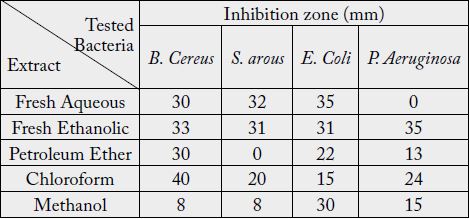

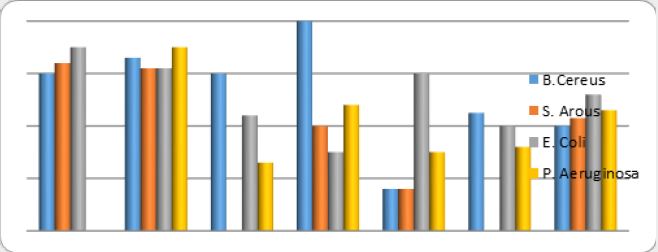
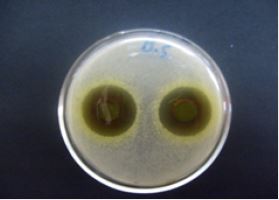
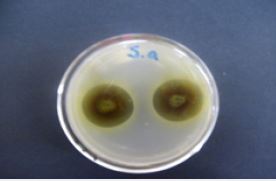
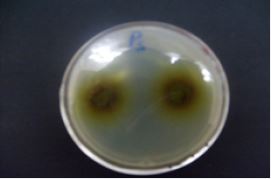
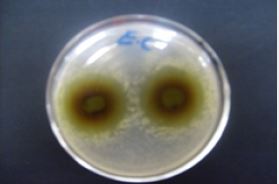
The results of the phytochemical screening of Moringa oleifera leaves revealed presence of, tannins, alkaloids, flavonoids, anthraquinones, glycosides, sterol, deoxy sugar, triterpenes, saponin, and cummarins.
Moringa oleifera phytochemical screening for ethanolic extract revealed the presence of sterol in agreement with [10], alkaloid, flavonoids, saponin and tannins which was reported by [11]. In this current study, cummarins, glycosides, and deoxy sugars were found in Moringa oleifera leaves but are not yet reported by other studies.
For the anti-bacterial activity, it was found that different extracts of Moringa oleifera leaves were active against bacteria such as E. Coli, S. Arous, P. Aeruginosa, and B. Cereus, as these organisms range from pathogenic and toxigenic organism liable to cause food borne illnesses, and foodspoilage due to bacteria presence. [12] reported that possession of alkaloids, tannins and flavonoids enhanced anti-bacterial properties of plant. In addition, the anti-bacterial activity of Moringa oleifera leaves for different species of bacteria was highlighted by many authors [11,13-16].
The experiments were carried out using five extracts of Moringa oleifera leaves (Fresh aqueous, fresh ethanolic, petroleum ether, chloroform, and methanolic extract), which was applied on four species of bacteria (S. Arous, P. Aeruginosa, E. Coli, and B. Cereus), it was found that Fresh ethanolic extract was highly active against all mentioned species. B. Cereus and E. Coli are highly sensitive to petroleum ether extract while S. Aureus, and P. Aeruginosa were resistant.
B. Cereus was the most sensitive bacteria to chloroform extract; P. Aeruginosa and S. Aureus were also sensitive, while E. Coli showed lower sensitivity. Methanol extract is highly active against E. Coli, but has a lower activity against P. Aeruginosa but S. Arous and B. Cereus are highly resistant.
Conclusions
It can be concluded that Moringa oleifera leaves extracts with different solvents are effective and with good
anti-bacterial activity against certain bacteria. Ethanolic extract is very effective against the four types of
bacteria in this study and other extracts are effective selectively for certain bacteria. Compared to standard
drug (Gentamycin), ethanolic extract showed double activity against bacteria. Therefore, it is recommended
to consider Moringa oleifera leaves as anti-bacterial medicine.
Acknowledgement
The authors would like to thank Prof. Eltohami S.M., Department of Pharmacognosy, Omdurman Islamic
University, Sudan, for his special support for this research work. Thanks to University of Malaysia Pahang
for financial support to conduct this work.
Bibliography

Hi!
We're here to answer your questions!
Send us a message via Whatsapp, and we'll reply the moment we're available!